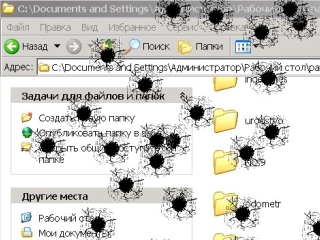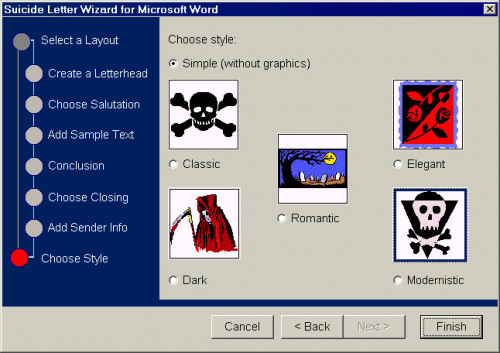Software art
Olga Goriunova, September 2007
The term ‘software art’ acquired a status of an umbrella term for a set of practices approaching software as a cultural construct. Questioning software culturally means not taking for granted, but focusing on, recognising and problematising its distinct aesthetics, poetics and politics captured and performed in its production, dissemination, usage and presence, contexts which software defines and is defined by, histories and cultures built around it, roles it plays and its economies, and various other dimensions. Software, deprived of its alleged ‘transparency’, turns out to be a powerful mechanism, a multifaceted mediator structuring human experience, perception, communication, work and leisure, a layer occupying central positions in the production of digital cultures, politics and economies.

gun.exe by Anonymous
The history of framing ‘software art’ allowed for inclusion of a wide variety of approaches, whether focused on code and its poetics, or on the execution of code and art generated ‘automatically’, or on the visual-political aesthetics of interfaces and ‘languages’ of software, or on the traditions of ‘folklore’ programmers’ and users’ cultures creation, use and misuse of software, or on software as a ‘tool’ of social and political critique and as an artistic medium, even perceived within the most traditionalist frameworks, and many more. ‘Genres’ of software art may include text editors that challenge the culture of writing built into word processing software and playfully engage with the new roles of words, all indexed in the depths of search engine databases; browsers, critically engaging with the genre of browser software as a culturally biased construct that wants to both trigger and control users’ perceptions, ideas and desires; games, rebelling against chauvinist, capitalist, military logic encoded into commercial games and questioning the seeming “normality” of game worlds; low-tech projects based on creative usage of limited, obsolete algorithms; bots as pieces of software that, like normal bots, crawl the web in gathering information or perform other tasks, but, unlike them, reveal hidden links, perform imaginative roles and work against normative functions; artistic tools working towards providing new software models for artistic expression and rich experience, sometimes made in spite of mainstream interface models; clever hacks, deconstructions or misuse of software; projects providing environments for social interactions, including non-normative, or looking at the development of software as a social praxis, and many others, complex enough or too elegantly simple to be locked into the framework of a single ‘genre’[1].

Portrait of the President (putin.exe) by Vladislav Tselisshev
Software art as a term appeared around the late 1990's from net art discourse[2]. Interest in the code of Internet web-pages and the functioning of networks, characteristic of net art, developed towards problematising software running Internet servers and personal computers, towards different kinds of software behind any image, process, instrument or channel[3].
Since software can be defined as a set of formal instructions that can be executed by a computer, or as code and its execution at the same time[4], a history of precursors of software art, including permutational poetry, Dada and Fluxus experiments with formal variations and, especially, conceptual art based on execution of instructions, can be retrospectively built[5].

Wasted time by Anonymous
Software art’s relation to net art and art history does not exhaust its ‘roots’ and scope of approaches in a historical context. One of the forces of software art lies in its capitalization on the grass-roots traditions of programmers’ and users’ cultures of software creation and usage, some ‘digital folklore’, and in its references to more specific traditions, such as demo (a multimedia presentation computed in real time and used by programmers to compete on the level of the best programming graphic and music skills, originating from the hackers’ scene of the early 1980's, when short demos were added to the opening visuals of cracked video games) and some other powerful and old traditions, such as generative art, rooted in both artistic and programmers’ cultures.

Suicide Letter Wizard for Microsoft Word by Olga Goriunova
Since the 1950's (when the first high-level programming languages were created and when the first mainframe computers were bought by a few large universities) smart and funny uses of technology, entertaining games, code poetry contests, fake viruses and other forms have been building up cultures of ‘digital folklore’: ‘… there is the field of gimmicks, nerdy tricks and playing with the given formulas, the eyes which follow the mouse pointer. … there is the useless software production, insider gags, Easter eggs, hidden features based on mathematical jokes, the Escher - trompe-l'oeil effects of playing with perception…’[6] Digital folklore exists in relation to a group of programmers, designers or informed users worldwide; it embeds, and is embedded within, codes of behaviour, of relations to employers and customers, to users, colleagues and oneself; it is correlated with the most important institutes, repeated actions, situations, models and is often based on non-formal means of production, dissemination and consumption. The variety of software cultures rooted in ‘geek’ practices, traditions of ‘bedroom’ cultures, cultures of software production and patterns of usage and adjustment build up sources of inheritance and inspiration for software art along with activist and artist engagements with software, each with histories of their own.
Software art benefited from currents of interest of more academic nature in the cultural and socio-political contexts of technology and, precisely, software[7]. The current form and ‘state’ of software art is due to a particular history of institutional development[8]. There also could be named a number of projects, practices and discourses conceptually and practically close to what is termed ‘software art’, which chose or happened to distance themselves from the usage of this term and from its institutional incarnations, for their potentially ‘limiting’ character in linking it to specific art fields, histories, and agents[9]. Moreover, departing from the term ‘software art’ might allow for starting up new stories and making visible some undervalued and overlooked practices and approaches.
Notes
[1] The above-mentioned ‘genres’ are taken from Runme.org software art repository’s ‘taxonomy’ that includes more categories than listed and presents one of the attempts to be open to a wide variety of approaches by building contradictory and, to a degree, self-evolving classificatory ‘map’ of software art.
[2] One of the first written mentionings of the term ‘software art’ can be found in Introduction to net.art (1994-1999) by Alexei Shulgin and Natalie Bookchin; http://easylife.org/netart/
[3] Deconstructions of HTML by Jodi, for instance, turned into the modification of old computer video game Wolfenstein 3D - SOD (1999) and other games. Projects such as alternative web browsers that were considered part of the net art movement started to be written back in 1997 with Web Stalker by I/O/D, continued by Web Shredder by Mark Napier in 1998, and Netomat by Maciej Wisniewski in 1999, and often got labeled as ‘online software art’.
[4] Cramer, Florian. Concept, Notation, Software, Art. 2002; http://userpage.fu-berlin.de/~cantsin/homepage/writings/software_art/con...
[5] Ibid. See also: Cramer, Florian and Gabriel, Ulrike. Software Art. 2001; http://www.netzliteratur.net/cramer/software_art_-_transmediale.html and Albert, Saul. Artware.1999. Mute, Issue 14, London. http://twenteenthcentury.com/saul/artware.htm
[6] Schultz, Pit. Interviewed by Alexei Shulgin. Computer Age is Coming into Age. 2003. http://www.m-cult.org/read_me/text/pit_interview.htm
[7] It is difficult and lengthy to enumerate all the interesting publications on the issue. An excellent example is Software Studies: a Lexicon. Ed. by Matthew Fuller, 2008, Cambridge, The MIT Press.
[8] Transmediale, Berlin-based media art festival introduced an ‘artistic software’ category in 2001 (ran until 2004), Readme software art festivals (2002-2005) and Runme.org software art repository (running from 2003) added on to the construction of the current ‘layout’ of ‘software art’ if it is taken as a scene defined institutionally. The list of events is continued by exhibitions, such as I love you [rev.eng] (Museum of Applied Arts Frankfurt, 2002; (http://www.digitalcraft.org/iloveyou/), Generator (Liverpool Biennale, 2002; http://www.generative.net/generator/), CODeDOC (Whitney Museum, NY, 2002; http://artport.whitney.org/commissions/codedoc/index.shtml), and a number of symposiums, conferences and discussions.
[9] Matthew Fuller, for instance, suggested ‘critical software’, ‘social software’ and ‘speculative software’ as generic titles for practices software art attempted to draw in; see: Fuller, Matthew. Behind the Blip, Software as Culture. (some routes into “software criticism”, more ways out). 2002. In: Fuller, Matthew. Behind the Blip. Essays on the Culture of Software. 2003, New-York, Autonomedia.
Images
[1] gun.exe by anonymous
[2] Portrait of the President (putin.exe) by Vladislav Tselisshev, image courtesy of the author
[3] Wasted time by anonymous
[4] Suicide Letter Wizard for Microsoft Word by Olga Goriunova, image courtesy of the author



